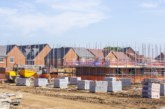
Nathan Priestley, Chief Executive Officer of the Priestley Group, discusses the need for planning reform when it comes to change-of-use applications.
When speaking about housing, Theresa May has placed a significant focus on simplifying planning legislation and the importance of ‘preventing urban sprawl’ by making better use of brownfield sites and existing buildings. Whilst in theory this should help meet the demands of a highly strained housing market, the reality is that the Government and local planning authorities are not doing enough to encourage the development of our existing buildings.
Our planning process is outdated and does not support the development of these buildings. It is complicated and decentralised, with each council adopting its own policies. One issue that seems to prevail all too often with change of use is rejection on parking/highways grounds. These buildings have an existing use where any amount of car travel and parking is already permitted. This doesn’t seem to matter. Planning policy on parking is often the same for both new-build and conversion, but how can both be viewed in the same way? Changing a building from offices to residential benefits the local highway as it decreases car travel compared to its former use.
To achieve the target of 300,000 homes a year by the mid-2020s, the Government needs to open up the process to allow any existing building, no matter what its current use, to be redeveloped into residential without the need for planning permission. This would free up sites ripe for development and give developers the confidence to commit millions of pounds of private funding into these schemes. Developing vacant buildings would also help to eradicate anti-social problems related to empty buildings and prevent overdevelopment of greenfield sites.
Permitted development (PD)
Currently, developers must navigate a complex process when submitting plans to turn existing buildings into residential properties. Although on paper, permitted development (PD) rights allow owners of a building to make certain changes and changes of use without planning permission, the reality is different. A formal application must still be made – referred to as a ‘Prior Approval Notification’ – negating the premise of PD.
Listed buildings
When applying for change of use with existing listed buildings, two applications have to be made: a normal planning application and a Listed Building application. The latter protects our heritage buildings and is overseen by a specialist conservation officer.
I am a big advocate of this as it is essential to protect our country’s heritage. However, in terms of permitted development, the main application, which has nothing to do with the listed status of the building, is completely excluded from PD. Why?
For example, we had a Grade II listed office block and were instructed to submit a full planning application (even though it qualified for PD) along with a separate Listed Building application. The listed building application, the most difficult to attain and there to protect the building, was granted with full consent for our proposed development. The main application for change of use, however, was rejected.
Open dialogue
At a time when the housing shortage is under intense scrutiny and more and more of our countryside is being lost to large housing developments, I urge the Government to make substantial planning changes for existing buildings. We need an open dialogue with the developers that operate in this sector – and planning consultants who have a history of developing existing buildings – to understand the current realities and issues facing this type of development.








